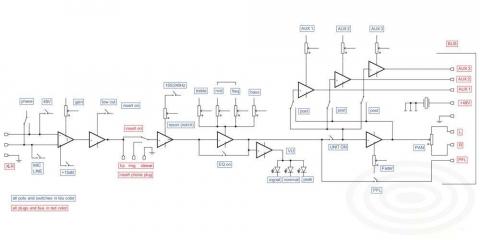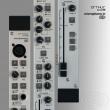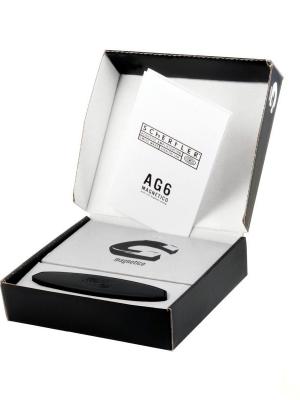This is the Schertler Arthur high-end microphone preamplifier, with several innovative features, specially designed for best possible sound reproduction.
The XLR input (MIC IN) can receive balanced signals from -63 dBu to +18 dBu. (A range of 81 dB, which therefore permits connection of any audio signal.)
The GAIN knob will amplify a weak signal to a nominal level of 0dBV, or attenuate a stronger signal, so that a nominal signal of 0dB is always present at the output of the mic input amp.
The VU level meters display the amount of Gain set. The headroom from input to output enables fairly strong overloads to be absorbed by the mixer's electronics, without producing distortion. Gain can therefore be set so that the red "overload" occasionally shows.
The +15dB and MIC-LINE buttons help control the Gain. The +15dB button is automatically excluded when the MIC-LINE button is pressed (as it doesn't make sense to amplify and attenuate a signal at the same time). Depressing the MIC-LINE button to "line position" (green light) and setting the Gain on "U" (unity gain) means that the mic preamp will neither amplify nor attenuate the signal. This is the correct setting for nominal 0 dB signals, or line signals from professional devices like limiters, effect units or recorders.
The PHASE button swaps the "hot" and "cold" aspects of the input signal, inverting the signal's phase 180 degree. Helpful if two microphones are positioned at a distance, or reverse-faced (i.e. for top and bottom snare drum miking).
Depressing the P 48 button (blue light) delivers 48V of phantom power to the microphone, which, in most cases will be a condenser, or active ribbon mic. Only use this button for mics that you know need phantom power in order to work.
The low cut button limits low frequencies at 100Hz/second order, removing unwanted low frequencies from "boomy" signals. It is also helpful in shaping signals from smaller instruments (violin, mandolin etc).
The INSERT-DIRECTOUT button works in a similar way to that on other mixers, while offering extra possibilities with an additional bypass switch: If the INSERT DIRECTOUT button is not depressed (i.e. off, white light), the signal will not be interrupted by the entry of a phone jack into the Insert connector. If the INSERT DIRECTOUT button is depressed (i.e. on, red light), the signal will be interrupted and the Insert will work in the usual way.
The resonance filter (a kind of notch filter) is gradually adjustable over its attenuation level. If set to "flat" during recording, the filter will be totally bypassed, having no effect on the incoming signal. The filter is designed to avoid, or at least attenuate, feedback on acoustic instruments that are mic'd up in live situations using pickups such as the SCHERTLER DYN series. The 150Hz-240Hz button enables frequency choice: When the button is not depressed (green light) the filter attenuates at 150 Hz. When depressed, (blue light) the filter attenuates at 240 Hz. Keeping the RESONANCE button set to the far left on FLAT means that the filter will not be active. When the RESONANCE button is turned slowly clockwise, the filter gradually attenuates at the chosen frequency.Filters. Innovative filter circuitry enables loss of sound to be kept to an absolute minimum.
The filter section is bypassed (white light) or activated (green light) via the EQ ON button: Helpful for comparing a filter configuration with unfiltered sound. The EQ ON button does not bypass the RESONANCE filter. The HI knob enables the high range of the audio spectrum (5kHz to 20kHz) to be tuned from +/- 16dB with a slope of 18dB / octave. The MID knob, together with the MID FREQ knob, acts on frequencies from 250 Hz to 3.2 kHz, with amplification or attenuation of +/- 14 dB. The LOW filter knob enables signal adjustment from +/- 16dB within a range of 20Hz to 300Hz, with a slope of 12dB / octave. Flat filter positions are indicated by detents at the mid position of each knob.
The CHANNEL ON button connects or disconnects the output routing for all outputs (AUX 1, AUX 2, AUX 3 and L/R), except the PFL routing. Similar to the MUTE button on other mixers, its functionality is however reversed. When the CHANNEL ON button is depressed, all outputs are connected. Also, whereas a MUTE normally only disconnects the L/R routing (the channel’s fader), this unit's CHANNEL ON button affects all outputs. Note: Even if the CHANNEL ON button is in the switched off position (white light), the PFL and INSERT will still be ready to function, (as shown by the white lights on their respective buttons), even though all other button lights are off.
Three AUX SEND knobs enable independent level control of each send (AUX 1, AUX 2, AUX 3). The sends can also "read" signals pre or post fade, through the use of switch buttons. If a button is not depressed (white light), the signal arrives "post fade" i.e. while the relevant auxiliary level is controlled by its level knob, the final outcome is also influenced by the channel fader's position.If a button is depressed (red light), the signal arrives "pre fade" and is sent to the AUX master without being affected by the channel fader's position or movement. Note: To benefit from all the AUX sends (and other additional options), a MASTER AUX unit is required as well as the MASTER L/R unit. The MASTER L/R unit only receives AUX 1 and is intended for a basic configuration, for example, when only one auxiliary send is needed to operate a reverb device.
PFL BUTTON. The PFL can only be operated through the MASTER AUX unit. As well as being a traditional PFL (pre fade listen), it also serves as a fourth AUX send (without the possibility to set any level). Signals from any channels with an activated PFL (red light) will be mixed in the MASTER AUX unit and sent to the PFL output, controlled by the PFL fader on the master AUX unit. Note: The PFL section still runs if the CHANNEL ON button is deactivated (white light).
L / R FADER section. In most cases, the signal going through here will be mixed in the L/R Master before appearing on the main L/R outputs that drive the recording device or the front-of-house PA speakers. Operating the L/R fader section is the same as on other mixing consoles.
The PAN pot enables signal to be sent to the Left or Right channel by turning it in the appropriate direction. At the pot's mid position, the signal flows to both channels at maximum level.





